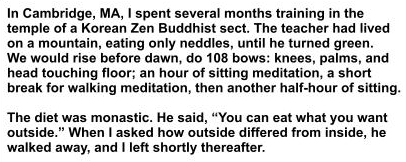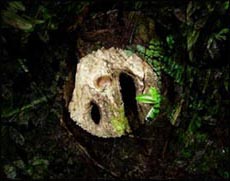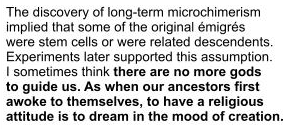October 8.
With tongue-in-cheek,
Stephen Hawking, through the computer that emulates his
voice, said : "I don't think there is much survival advantage
in discovering the ultimate theory of the universe, because it doesn't
have
any practical applications."5 Yet,
as creative beings, we will continue to probe for ultimate theories.
The
creative wrinkle may have occurred when the human brain became conscious
of itself by reaching a bilateral agreement on a subject. As we are a
social species, the surfaces gleam in the
sunlight and glisten in the rain. The rock surfaces are rarely pure white,
except when seen from a distance. They range in colour from an off-white
creamy surface, to shades of silver and blue-grey. In places
the initial stages of art were performed in concert with various
stages of sacred and secular rites.
When I bought
what I thought were rechargeable batteries for my camera, only
to discover they weren't, instead of returning them I found that
the camera worked better. Rechargeable batteries are an elegant
idea, but the chemistry of their cells weakens with each resurrection.
I
was thinking again about gods who can be plowed back into the
earth, or seeded into
the sky, to grow greener gods, or rain fresh ones down onto a parched
imagination, as re-ligere is literally the relationship
between earth and sky. A new god gestating in Earth's womb. "Who
is this new visitor? What is this oscillating, fluid mystery
inhabiting her
body? Is it human or vegetable, monster or something completely unknown
to our collective psyches?"6
Sudden
shower—
beneath a tree’s
branches,
robin and I seek
shelter.
With
trees shaking their leaves like shamans rattling gourds, some years
ago, I sauntered onto the desert's deceptively attenuated body,
dodging an industrious army of ants, and black beetles who bounced
the sun off their backs as iridescent flames of purple and blue.
With nothing to startle a wary eye, I faced a distant mesa as if
its morphology still hid uncharted reveries.
In
New Mexico the ancient Native American fertility shrines are called
Mother Rocks; they are incised
with vulva symbols, male and female
figures, seeds, serpents, and rain symbols...7
A
small jack rabbit hopped out from behind a creosote bush's thick
lubricious smell, its tall ears rising like antennae from impervious
sand.
As memory
is reception, Mnemosyne's children are born with eyes wide open. "This
kind of artistic Memory begins as an embryonic potential that exists
in
and around the artist, a nascent spark of life that awaits its conception
in the artist's psyche"8
I
catch myself walking in circles, the city behind me melding and
dissolving into a
rational hum. The rabbit is gone, leaving the
fragments, preserved between sheets of glass, respond to the infra-red
spectrum—ink invisible to the naked eye can be seen and photographed.
The fragments form part of a giant 'jigsaw puzzle' to be reassembled.
Missing 'pieces' can be supplied from quotations by later authors,
and
a maze of prints, only slightly more human than not.
Here one is prone to ask foundational questions, such as: To arrive
at self-consciousness did we look in the wrong direction?
Genesis
announced the beginning of the development of a new kind of ego as
a new psychic construct in human
evolution. Characteristic of this ego was its allegiance to a deity
that was more like humans than like nature."9
In
Chinese folklore, rocks are the roots of clouds. Yet you can walk
for weeks in the desert and see only wisps of a jet plane's vapor,
a dragon's shadow crossing the sun, or the breath of an eagle diving
to snatch its prey. It wasn't by chance that all the monotheisms
were dowsed in the desert, as deserts pander to our thirst for
visions. Living
in New Mexico, one New Year's Day before dawn
I packed all my possessions in a hatchbacked car and drove toward
the East. A few hours later, sun lighting the desert,
I
turned and returned home.
For our
goal was not only the East, or rather the East was not only a country
and something geographical,
but it was the home and youth of the soul, it was everywhere and nowhere,
it was the union of all times.12
On
this mild overcast morning, the trail is dry again. Yet the
creek has retained
the volume of its recharged voice. “Talk of mysteries! Think
of our life in nature, daily to be shown matter, to come in contact
with
it, rocks, trees, wind on our cheeks! The solid earth! The actual
world! ”13
A forest is
immensely complex and fiercely individuated. At a glance so much
looks alike. On closer look, each tree, bush, leaf, green or
giving itself back to earth, is distinctive. Although scientists
parse and classify, understanding by elimination, reality is
not stable between forms; rather, it is deterritorialized, a
state in which
a subject no longer occupies a realm of stability and identity but
is instead folded
imperceptibly into a movement or into an amorphous legion
whose mode of existence
is nomadic or, alternatively, whose 'structure' is rhizomatic rather
than arborescent.14
A forest may be imagined as a
zone "of liberated intensities where contents free themselves
from their forms as well as from their expressions, from the signifier
that
formalized them.”15
As the
human mind abhors a state in which "all shapes become undone,"15
what is lost is rebuilt into different forms, in time as well as space.
These tropes, I suggest, are influenced by the myelin insulation of
the brain, which adjusts "conduction velocity so that volleys
of electrical impulses arrive at the same neuron simultaneously from
multiple axons."16
Although it is not completed until one's mid-twenties,
and will never coat all the axons, like packets of information sent
through the Internet via multiple pathways that arrive at a computer
precisely together, on a much more massive scale the brain is almost
always sending and receiving billions of signals from distant disparate
lobes that converge to form the sensate patterns that are our experienced
life.
I am
going to school myself so well in things
that, when I try to explain my problems,
I shall speak, not of self, but of geography.17
C.G.
Jung opined that
the West "with its bad habit of wanting to believe (in
Asiatic religions) on the one hand, and its highly
developed scientific and philosophical critique on the other, finds
itself in a real dilemma."18
He counseled that Westerners remain to true their parents' religion,
usually Judaism or Christianity, which were themselves
imported from
the Orient.
It's
been nearly a century since Zen Buddhism arrived in America, and
it still hasn't settled into this country's cultural norms. Its
indigenous teachers continue to confirm their lineage in Japan,
although some of its aesthetics have entered Western spaces. Thus,
I am sitting in a Japanese Garden reading the poems of Taneda Santōka,
who was an unhappy mixture of Zen priest and incurable alcoholic—
I
cannot seem to die,
on the other bank a red flower blooms.19
 |

|
How to return
with dignity to the communal house, where I'd been comfortably
living? What madness made me give that up for the ascetics of someone
else's culture? When I finally announced I was leaving the temple,
to continue the practice under other conditions, they didn't let
me buy the gray robe I'd worn through so many arduous hours. Defrocked,
then, I joined the dusty world again.
In 2004, Zen
Master Sueng Sahn passed away at a temple in Seoul, Korea. His
teaching was "the don't-know mind."
Clear
morning sky—
a green flower blooms
on Sueng Sahn Mountain.
21.
When
the innards of computers were still mysterious, it was "Garbage
in...garbage out." Yesterday's information is still
tossed out, and wisdom is still looked for in the distant
past. At
the cusp of the 20th Century, an Alutiiq youth “was
turned into a shaman by his maternal uncle, who put the
boy in a garbage pit for a
whole winter. When the boy emerged unharmed in the spring ‘He
knew what was on everyone’s mind. He knew a
further structurally negative characteristic of transitional beings
is
that they have nothing. They have no status, property, insignia,
secular clothing, rank, kinship position, nothing to demarcate them
structurally
from their fellows. Their condition is indeed the very prototype
of how
people would live in the future. He was a person who knew things.’”20
27.
Last
Friday night, after a mild day, New York analyst Morgan Stebbins
delivered a talk to Oregon Friends of C.G. Jung. Its title, "Context
and Essence," was abstract enough to encourage him to traverse
a large area of uneven ground, if rather too quickly. His talk
was in two parts, connected by Jung's teaching that "we
conceive of dreams as purposive and meaningful causal connections."
Furthermore,
it lies in the nature of the earliest dreams of childhood that one
usually does not get related associations: they are a manifestation
of a part of the unconscious, standing alien in time. These early
dreams in particular are of the utmost importance because they are
dreamed out of the depth of the personality and, therefore,
frequently represent an anticipation of the later destiny.21
Decades
later we received James Hillman's acorn theory: "The myth
says that the roots of the soul are in the heavens, and the
human grows downward
into life. A little child enters the world as a stranger, and brings
a special gift into the world. The task of life is to grow
down into this
world,"22
|
 |
 |
The
religious attitude is "a dynamic existence or effect not caused by
an arbitrary act of will."23
Paraphrasing Jung, Stebbins illustrated this attitude
by projecting ten Oxherding Pictures from 13th Century China that represent
the stages of consciousness Zen students continue to seek, Ox representing
the wandering mind.
then projected
pictures from the Rosarium philosophorum, medieval renderings
of alchemy's quest for the Philosopher's Stne, which parallels
the Oxherding pictures
in that they both seek a realization of mind-in-world: one hrough suchness,
the
other through substance. And while some alchemists
toiled to harness their imagination only, "to the alchemist, the
magian, the Sufi mystic, and to Jung, the imagination was anything but
unreal."26
1-
Bering, J. "The End?" Scientific American Mind. Oct/Nov
2008.
2- Snyder, G. From, "For/From Lew." Here the ghost of the poet
Lew Welch appears to teach his old friend.
3- Vitebsky, P. "From Cosmology to Environmentalism: Shamanism as
Local Knowledge in a Global Setting.” In, G. Harvey, Editor, Shamanism:
A Reader. London, England, 2003.
4- Nils-Udo. “Towards Nature.” In, H. Besacier, Nils-Udo:
Art in Nature. Paris, France, 2002.
5- Hawking, S. "If There's an Edge to the Universe, There Must Be
a God." In, R. Weber, Interviewer, Dialogues with Scientists
and Sages. London, England, 1986.
the surfaces gleam in the sunlight: C. Tilley, The Materiality of
Stone. Oxford, England, 2004.
6- Cowan, G. "The Sacred Womb." In, M. Tobias and G. Cowan,
Editors, The Soul of Nature. New York, NY, 1994.
7- Lippard, L.R. Overlay:Contemporary Art and the Art of Prehistory.
New York, NY, 1983.
8- Hort, B. "The
Sacred Story of the Divine Hush." Spring Journal 70 (2004).
the fragments, preserved
between: D. Keys and N. Pyke, “Decoded at last..." The
Independent News Service. 17 April 2005.
9- Bernstein, J.S. Living in the Borderland. London, England,
2007.
10- Bishop, P. Dreams of Power. London, England, 1993.
11- Jabès, E. "The Desert." In, From the Book to
the Book: An Edmund Jabès Reader. Hanover, NH, 1991.
12- Hesse, H. The Journey to the East. New York, 1972.
13- Thoreau, H.D. The Maine Woods. Harper & Row: New York,
NY, 1987.
14- Bruns, Gerald S. "Becoming-Animal (Some Simple Ways)" New
Literary History. Vol. 38, 2007.
15- Deleuze, G. and Guattari, F. Kafka: Toward a Minor Literature.
Minneapolis, MN. 1986.
16- Fields, R.D. “White Matter Matters.” Scientific American,
March 2008.
17- Neruda, P. From, “We Are Many."
18- Jung, C.G. Psychology and Religion, West and East. Collected
Works, Vol. 11. Princeton, NJ, 1976.
19- Santōka, T. Written in 1939, a year before he died.
20- Crowell, A.L. and Leer, J. "Ukgwepet—'Our Bodies.'”
In, A.L. Crowell, et.al., Editors, Looking Both Ways: Heritage and
Identity of the Alutiiq People. Fairbanks, Ak, 2001.
a further structurally negative characteristic:
V. Turner, “Betwixt and Between: The Liminal Period in Rites of
Passage." In, L.C. Mahdi, et.al., Editors., Betwixt & Between:
Patterns of Masculine and Feminine Initiation. LaSalle, IL, 1987.
21- Jung, C.G. "On the Method of Dream Interpretation."
Children's Dreams. L. Jung and M. Meyer-Grass, Editors. Princeton,
NJ, 2008.
22- Hillman, J. "The Soul's Code: An Interview with James Hillman."
M.N. Stearns, Interviewer. http://www.personaltransformation.com/Hillman.html
recent research suggests: J.L. Nelson, “Your Cells Are My Cells,”
Scientific American. February 2008.
23- Jung, C.G. Psychology and Religion. New Haven, CT, 1938.
24- Weishaus, J. Oxherding: A Reworking of the Zen Text. With Block
Prints by Arthur Okamura. San Francisco, CA, 1971. The pictures
adove were made by the contemporary artist, Tomikichiro Tokuriki.
25- Dōgen, E. "Mountain and Waters Sūtra." In, K. Tanahashi,
Editor, Moon in a Dewdrop: Writings of Zen Master Dōgen.
New York, NY, 2000.
26- Raff, Jeffrey. Jung and the Alchemical Imagination. Berwick,
ME, 2000.
|
